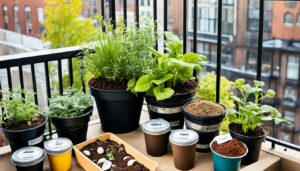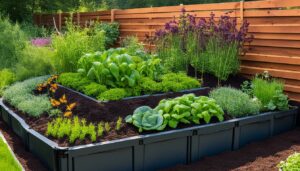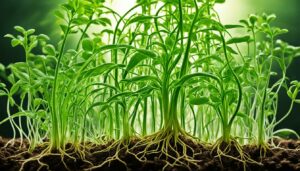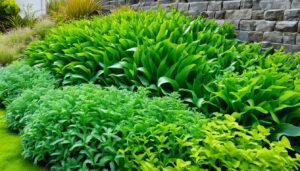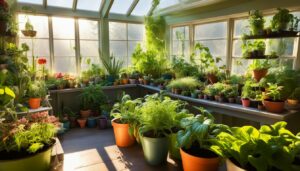An astounding 40% of residential water is estimated to be used for lawn and garden maintenance across the drought-prone state of Texas, spotlighting the critical need for rainwater harvesting and garden water conservation strategies. By turning to DIY rainwater collection, Texans are taking the reins on sustainable water management. This initiative not only empowers gardeners with an abundant supply of soft, chlorine-free rainwater but also acts as an eco-friendly water solution, diminishing the reliance on municipal water systems and reducing overall water consumption.
In this light, one can see that adopting rainwater storage systems is more than a mere gardening trend; it’s a vital resource management practice that benefits both the environment and the meticulous gardener aiming to nurture their oasis. With the expertise of organizations like Texas A&M AgriLife’s Water University program, the journey towards creating a water-wise garden is made seamless and effective.
Key Takeaways
- Integrating rainwater harvesting systems significantly aids in garden water conservation and management.
- DIY rainwater collection can drastically reduce household reliance on municipal water supplies.
- Collected rainwater provides an ideal pH balance, beneficial for plant health and soil integrity.
- Sustainable water management includes both capturing rainwater and employing strategic usage.
- Educational resources such as Texas A&M AgriLife’s Water University offer valuable guidance for setting up eco-friendly water solutions at home.
- Maintaining a rainwater storage system is key to ensuring water quality and maximizing collection efficiency.
Understanding the Basics of Rainwater Harvesting
Embarking on the journey of DIY rainwater collection starts with a fundamental grasp of how and why it’s a sustainable choice for both your garden and the planet. By tapping into the underrated potential of the rain, individuals can engage in water conservation methods that boast numerous benefits. Let’s delve into the reasons why rainwater is your garden’s best friend, the steps to locating prime catchment areas right on your property, and the environmental plus economic upsides to this green practice.
Why Rainwater is Superior for Plant Care
Rainwater, unlike its municipal counterpart, comes to us naturally soft and completely devoid of the chemicals that could compromise plant wellness. This absence of chloramines, fluorides, and dissolved salts means that rainwater is inherently aligned with the needs of plants, promoting healthier growth and maintaining the life-giving quality of your soil – a cornerstone of eco-friendly water solutions.
Identifying Catchment Areas on Your Property
Every home is a hotspot for potential rainwater catchment. Areas such as the roof, downspouts, and other inclined surfaces can be transformed into springboards for sustainable water management. These spaces are valuable in funneling the water where it can be stored and later used, reducing our outsized ecological footprint one drop at a time.
The Environmental and Economic Advantages of Rainwater Collection
On both macro and micro levels, redirecting rainwater to where it can quench your garden’s thirst is a win-win scenario. Environmentally, it’s an ace up the sleeve in the game of resource preservation, and economically, it’s like putting money back into your pocket every time the clouds gather. By embracing simple water conservation methods such as rainwater harvesting, you’re not just cutting down on utility bills, you’re also participating in a grander scheme to ensure that the faucet never runs dry for future generations to enjoy and sustain life.
Setting Up Your DIY Rainwater Collection System
Engaging in DIY rainwater collection is a rewarding and sustainable practice that greatly aids in water conservation efforts. By assembling your own system, you can effectively manage water resources while ensuring a regular supply for your garden and other non-potable needs.
Choosing the Right Containers for Storage
When setting up your rainwater storage systems, the selection of the right containers is paramount. Ideal containers are those that are capable of holding a substantial amount of water while maintaining the integrity of the water stored within. Commonly used for this purpose are food-grade barrels, which are designed to support the safe storage and cleanliness of the water they contain, essential for any sustainably managed garden.
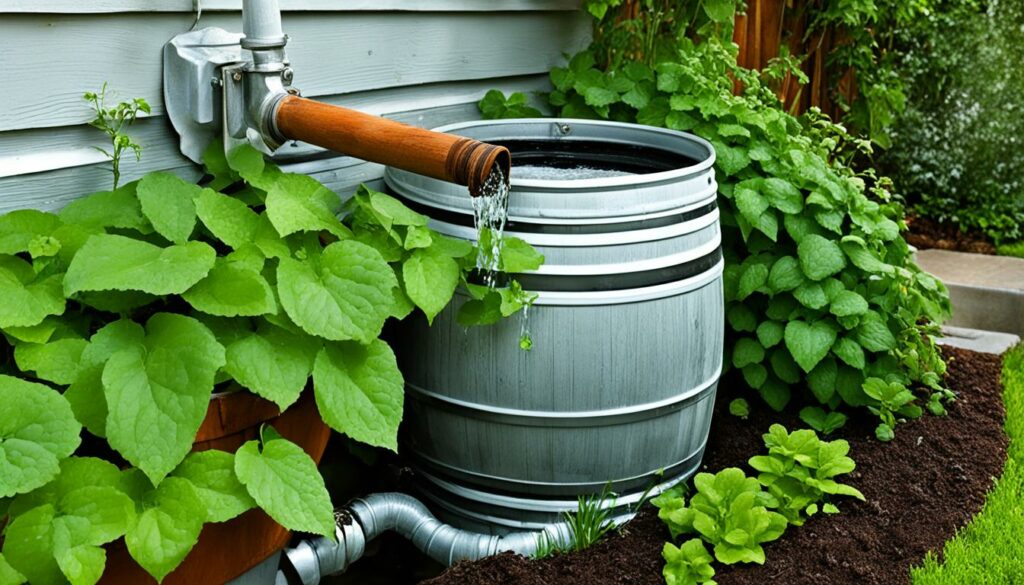
Ensuring Cleanliness: Food-Grade Barrels and Their Importance
The usage of food-grade barrels cannot be overstated in the realm of DIY rainwater collection; their quality standards ensure that water collected is free from harmful contaminants—a core aspect of sustainable water management. It is crucial to select barrels that were used solely for food substances to prevent potential chemical contamination from non-food materials.
Creating a System to Divert Water from Roof to Barrel
Once storage is secured, the next step in crafting your rainwater collection framework is to establish a diversion system. This involves using existing structures like downspouts or creatively incorporating decorative elements such as rain chains to channel rainwater efficiently from your roof into the barrels. With a suitably placed rain barrel, homeowners can capture valuable rainwater with ease, thereby enhancing their rainwater storage systems for a variety of uses.
Rainwater Harvesting and Garden Water Conservation Techniques
In the heart of Texas, where arid landscapes reign and rainfall is unpredictable, homeowners are turning to rainwater harvesting as a substantial method for garden water conservation. This practice doesn’t just alleviate the stress on local water supplies; it’s an essential part of sustainable water management, ensuring that gardens remain lush and ecosystems thrive, even amid prolonged dry periods. Below are insights into crafting an efficient rainwater harvesting system in your own backyard.
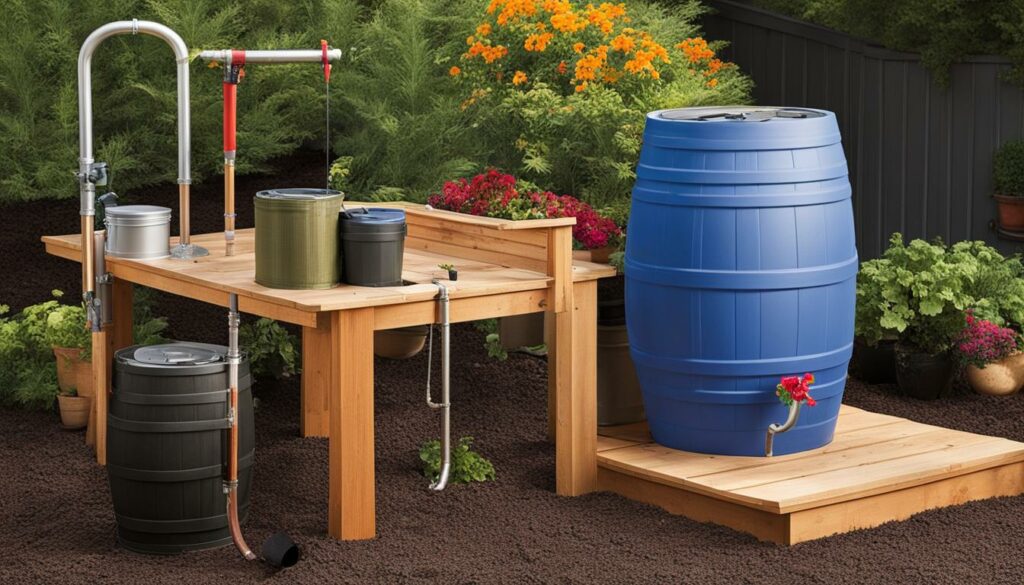
The journey to self-sufficiency starts with setting up a DIY rainwater collection system. Simple yet effective, these setups often involve repurposing containers and utilizing natural landscape features to support water conservation efforts. Many Texans have taken advantage of the resources provided by Texas A&M AgriLife, which offers step-by-step guides and tutorials to assist homeowners through the process.
- Assess Your Space: Identify catchment areas such as roofs or angled surfaces where water naturally flows.
- Choose the Right Containers: Use food-grade barrels to ensure the cleanliness of your collected rainwater.
- Direct the Flow: Implement gutters or rain chains to channel water efficiently into your storage containers.
- Maintain Water Quality: Consider installing filters to keep debris out and ensure the water remains clear and usable for your garden.
By capitalizing on these elements, you not only contribute to the environment but also to your own peace of mind. You’ll be able to maintain your garden’s vibrancy with naturally soft rainwater, which is free from the chemicals found in municipal water. Moreover, you’ll engage with the community of like-minded individuals who prioritize ecological responsibility and the conservation of our water resources.
Join the movement in garden water conservation and play a part in the sustainability of our planet’s future. As the saying goes, “Every drop saved is a drop earned,” and with rainwater harvesting, your garden can become fertile proof of this eco-friendly creed.
Maximizing Garden Water Conservation through Storage and Usage
As we delve into the effective strategies for augmenting garden water conservation, it becomes evident that the architecture of rainwater storage systems plays a foundational role. The judicious use of harvested water, reinforced by calculated collection methods and eco-friendly water solutions, can significantly impact our conservation efforts. Let’s explore how the relationship between roof size, rainfall, and soil moisture control can lead to a greener, more sustainable garden environment.
Calculating Collection Potential with Roof Size and Rainfall
In regions like Texas, where each rainfall presents a valuable opportunity for water collection, the metrics of your roof can be a game-changer. A practical formula to estimate the potential captures the essence of efficiency in water conservation methods:
For every inch of rainfall, a square foot of roof yields over half a gallon of water.
This calculation implies that even a modest amount of rain can translate into an ample water reserve for your garden, positioning rainwater storage systems as a cornerstone of garden water conservation.
Implementing Efficient Irrigation with Harvested Water
Having established the potential of rainwater accumulation, the spotlight turns to the utilization of this bounty. By integrating rainwater into existing irrigation frameworks, the dependence on municipal water supplies notably decreases. The concept of ‘efficient irrigation’ encompasses the targeted distribution of water at the root zones of plants, thereby ensuring maximal usage of every conserved droplet.
Using Soil Moisture Meters for Water Conservation
In an era where precision is paramount, soil moisture meters emerge as the protagonists in the narrative of water conservation. These devices offer a real-time assessment of soil hydration, allowing gardeners to water their plants with surgical accuracy. Such eco-friendly water solutions ensure that water is supplied only when necessary, fostering a responsible stewardship of our water resources.
Garden water conservation is not a mere act of preservation; it is an ongoing commitment to an environmentally conscious lifestyle. As we harness the synergies between sophisticated rainwater storage systems and frugal water usage practices, we pave the way for a future where water is revered and judiciously utilized.
Sustainable Water Management: Protecting Your Harvest
Integral to sustainable water management is the efficient use of collected rainwater, leveraging eco-friendly water solutions to maintain a thriving garden. It’s not just about capturing rainwater but ensuring it serves its purpose effectively while also contributing to garden water conservation. Protection of your rain reserve is twofold: it involves preventing contamination and optimizing usage.
Firstly, the inclusion of filtration units plays an essential role in keeping the stored water clean by blocking debris and organic matter, which could otherwise lead to blockages or degradation of water quality. A filtration system can be as basic as a mesh screen over the barrel or as complex as a multi-stage filtration unit, depending on the intended use of the harvested water and personal preference.
Additionally, mosquito-proofing your storage containers is vital to prevent the breeding of mosquitoes and other insects that can not only contaminate the water but also pose health risks. Simple solutions include tight-fitting lids or mesh screens that allow water to enter while keeping pests out.
Reducing water evaporation is also at the heart of conserving every precious drop. Covering your storage units to limit exposure to sun and wind can greatly minimize loss due to evaporation. Furthermore, implementing a proper overflow system ensures that during heavy downpours, excess water is directed away from the foundations of your home, avoiding potential damage.
- Installation of filters to trap debris
- Mosquito proofing with mesh screens
- Covering tanks to reduce water evaporation
- Setting up overflow systems to handle excess water
Lastly, regular maintenance of your rainwater storage systems cannot be overstated. Regular checking and cleaning of gutters, inspections of connecting hoses and faucets, and timely cleaning of storage units will ensure that your system remains functional and effective for years to come.
With these protective measures in place, gardeners can secure an ample amount of high-quality water that can be utilized across a multitude of garden needs, substantially reducing reliance on municipal water systems and moving toward a more sustainable and eco-conscious gardening practice.
Accessorizing Your Rainwater Harvesting System for Efficiency
Enhancing your rainwater harvesting system with the right accessories can make a world of difference in its efficiency and integration into your garden’s environment. From functional components that increase collection capabilities to aesthetic touches that enhance garden design, the right accessories serve both practicality and pleasure, supporting your commitment to eco-friendly water solutions and sustainable water management.
Embellishing your system with artful rain chains not only contributes to a pleasant ambiance but cleverly guides water into your storage solution. These inventive alternatives to standard downspouts encapsulate the essence of form meeting function. Conversely, employing interconnected rainwater storage systems allows for an increased reservoir, ensuring that you capture as much rainwater as possible during the wetter seasons, critical for garden water conservation throughout dryer months.
Powering your irrigation with a pump can vastly increase water pressure and flow, enabling an effective water distribution network throughout your garden. Whether for a small flowerbed or an expansive landscape, controlled water pressure is the key to utilizing every drop efficiently.
“Not only does accessorizing your rain collection system increase its functionality, it also elevates the aesthetic of your garden, making it an attractive centerpiece that epitomizes practical sustainability.”
- Install rain chains as an attractive alternative to downspouts, enhancing beauty and water flow.
- Link multiple barrels or tanks together for ample rainwater storage, ensuring none of the precious resource is wasted.
- Conceal your storage tanks with decorative features to integrate them seamlessly into your garden.
- Add a pump to your system to facilitate better water distribution for irrigation needs.
Every addition to your rainwater harvesting set-up not only reaffirms your dedication to garden water conservation but also transforms your garden into a showcase of sustainability. The result is a water-wise garden that conserves resources while radiating natural beauty.
Conclusion
In the heartland of Texas, where the dance between drought and downpour is a customary ritual, the ancient practice of rainwater harvesting has modern-day champions. These stewards of the earth recognize the innumerable advantages of collecting the skies’ bounty for garden water conservation and sustainable water management. With the pure simplicity of rainwater, devoid of the harsh chemicals found in municipal water, gardens can flourish, nurtured by nature’s own eco-friendly water solution.
Handy homeowners have embraced DIY rainwater collection techniques, transforming rooftops into catchment zones and food-grade barrels into reservoirs of longevity for thirsty plants. Guidance and know-how, generously provided by Texas A&M AgriLife and programs like the Upper Trinity, have propelled these water conservation methods forward, empowering individuals to take a proactive role in safeguarding this precious natural resource. Proper rainwater storage systems not only preserve H2O for future use but also reduce dependence on strained utility systems and contribute to lower household expenditures.
As we draw from the well of shared knowledge and tool up for the task, we affirm our commitment to environmental stewardship. Whether our part is big or small, each drop in the collective bucket helps. The ripple effects of our efforts are clear, leading to lusher gardens, lighter utility bills, and a profound positive impact on the environment. Indeed, the sustainable use and management of harvested rainwater is a testament to the fact that sometimes, the best solutions fall straight from the sky.



